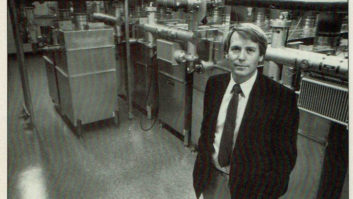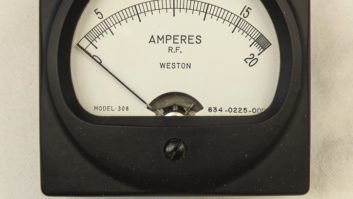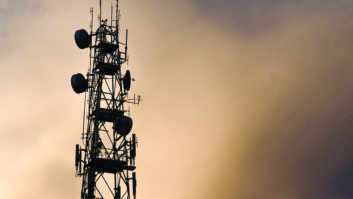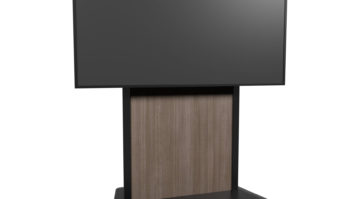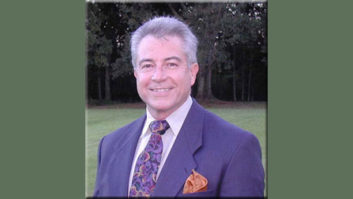DA maintenance
Nov 1, 2002 12:00 PM, By John Battison, P.E., technical editor, RF
Directional antenna maintenance is an ongoing process based on experience and adequate records. With the FCC’s reduced logging requirements, the paperwork involved is considerably less than in years past. Therefore, there is no excuse for a directional array not to have adequately written and readily available maintenance logs. Not only does a well-maintained log book provide a guide to daily operation, but it can give a great deal of diagnostic help when a crisis occurs � and even with the best of maintenance crises do occur. A quick glance at operating parameter records will often show that a situation has developed.
Physical changes, like this shifted tower base pier, can easily influence a directional array. Photo by Tracey Liston.

A properly recorded, correctly taken and regularly examined monitor point log is the best maintenance tool. The Commission no longer requires routine spaced monitor-point readings, so it behooves the conscientious engineer to have these readings taken regularly. Even a small change will be noticeable when compared to previous measurements, and will lead to a check of antenna monitor phase and ratio readings as well as common point current.
Electrical problems
A sudden large change in antenna monitor readings should lead to a check of the monitor points and log; it should never be followed by a frantic turning of phasor cabinet knobs in an effort to regain the normal monitor readings. In the absence of any drastic change in other operating parameters, such a monitor change should be followed by the usual checks, including common point current. If the system has a built-in operating bridge, the common point impedance should be checked whenever any of the out-of-limit readings are observed, and before assuming that the array has returned to operation in accordance with the license.
Even though regular inspections are a thing of the past, there is a lot to be said for the old-timer’s hand check of capacitor and inductor temperatures at sign-off, or even pattern change. A hot capacitor, a high temperature or a discolored inductor is one of the easiest checks to make to correct undesired and excessive RF current.
Look for warm spots in the transmission line. It’s not unusual for a line to be slightly warm, especially indoors where there is no breeze or air movement to cool it. Any hot spots are an immediate indication of high standing waves. AM antenna systems are usually tolerant of standing waves, but VSWRs high enough to cause heating are an indication of an improperly adjusted antenna system. This means getting out the operating-impedance bridge and checking the phasor and ATU lines to find the mismatch. Check actual base operating currents as well.
Post the phasor dial readings by each control knob, and also the common point’s upper and lower current limits by the common point ammeter. Similarly, posting the antenna monitor’s phase and current ratio limits close to the monitor makes for quick referral in a panic situation.
Tuning houses must be clear of debris inside and out. The components inside must also be corrosion free. Photo by Tracey Liston.

If the monitor points are in, the RF currents are normal and the antenna monitor is out, check the sampling lines. They should be buried and any excess also buried. There should be a record of the original sampling line impedances and dc resistances. Checking the immediate operation against the original values will offer a good idea of their condition. Trucks may drive over soft places around the tower and damage monitor lines.
If an antenna monitor or tower monitor input is suspect, it can be verified by changing the inputs to the monitor and comparing readings on different inputs.
Transmission lines are normally safely buried or mounted on adequate supporting posts. However, ice can damage lines in exceptional weather conditions and so can vandals, so don’t be too quick in dismissing these items in the long term examination.
It’s important to remember that RF current transformers in ATUs can be damaged by lightning or RF arcs, therefore, they should be examined for obvious damage and electrical performance. Ensure that the lightning-protection, single-turn ring in the RF connection to the ATUs is restored after work on tower bases. If this is omitted the next storm may take the station off the air.
Sometimes the insulators holding the tower-mounted RF current loops become cracked and change operating indications. A strong wind can move loops so that misleading voltages are picked up. Sometimes, a gale may move a loop, possibly the reference loop. This can produce strange antenna monitor readings that tend to lead one away from the actual mechanical problems. Anything that affects the reference tower loop (or current transformer) will impact the readings for the other towers, because it provides the reference voltage against which the other towers are checked.
It is not unusual for towers in directional arrays to support other devices such as FM or STL antennas. If the AM radiator is not shunt-fed, some form of feed-line isolation should be used. This can take the form of a horizontal, a vertical, a quarterwave isolating stub or an isocoupler to carry the line across the base insulator. Isocouplers can develop faults and they should not be ignored.
In the past, quarterwave sections have been finely tuned by an air capacitor across the section. This is an acceptable method of adjustment. However, many newer engineers have not come across this little gimmick. Sometimes a new engineer will remove or readjust these types of useful gimmicks, and cause themselves considerable work in readjusting the decoupling section.
Finally don’t forget the humble field mouse. Doghouses and even metal ATU cabinets attract these little animals in the winter, because there is protection from other animals and warmth from the RF energy. Sometimes an engineer will find roasted mice that have short-circuited coil turns. Regularly clean out the ATU cabinets or doghouses, and be sure to look for animal nests in RF areas. Snakes also like to come in out of the cold. The best way to keep wildlife out is to seal and close every conceivable entry point.
E-mail Battison at[email protected].

